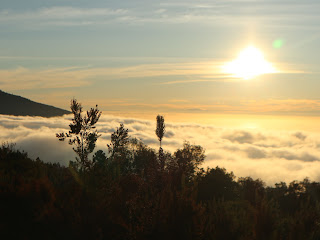Stargazing on Teide
Island hopping
As the ferry leaves the port of Santa Cruz, the neighbouring island of Gran Canaria, which I call home, comes into view on the horizon. The grey to beige cliff-lined cumbre cuts through a band of clouds that have formed like a ring around it.
I've seen four islands this weekend. From Los Cristianos, in the south, La Gomera was visible and last night the silhouette of La Palma's caldera caught the final rays of the setting sun from the observatory viewpoint at 2200m above sea level.
And then half way through this ferry journey, the outline of the mountains of Fuerteventura come into view. I last saw those three peaks in December last year. They are a camel with three humps.
Except, appearances can be deceptive - the towering blocks of Las Palmas come into view and cover the flat land of the isthmus. It was too good to be true. It was Confital. The newspaper had been right in December: Fuerteventura is only visible from Gran Canaria on rare December days at sunrise when the peaks are lit up, creating a morning silhouette.
Sunset Teide Adventure
We snake our way up the flanks of the volcano on the seemingly neverending series of hairpin bends that carve out a route up through the cloud forest. As we drive, we curiously check the temperature reading on the dashboard. We can see the height difference as we climb. However, there are no signs telling us what altitude we are at - so far. The temperature drops from 25° to 19°. We continue to climb and enter the cloud forest. Grey clouds emerge around us and when we think we must be near the top, a huge hillside appears, dotted with towering pine trees that look like nothing more than tiny hairs on the side of the great beast of the volcano. Those trees are at least another a thousand metres up from us.
The road continues and suddenly we leave the towns behind. The towns become villages and then the villages become scattered hamlets and villas. Then we climb further and the car reads 15°. Some of the numbers on the digital display don't light up properly and we try and guess the temperature.
The tarmac road swings around sharply and now we face west. The road winds up through the forest smoothly now and it offers us a time to pause from the curves....And there it is: the three thousand seven hundred metre volcano emerges between a gap in the dark green pine trees and we do nothing but gasp. Its beauty is breathtaking.
It is the third largest volcano on our planet. From the lowest seafloor it measures 8000m. Eruption upon eruption has created this stratovolcano of enormous proportions; its flanks really do reach up from the abyss.
What we see above the ocean is just the tip of a rock iceberg.
We continue up and before we know it, we are on the volcanic flat plains whose geologic origins are still very much debated. Erosion has created arguable sediments and... just how much sand does the calima bring from the Sahara every year? We continue up the observatory, and step outside to see the sunset. We last a minute and then go back to the car to layer up. It is blowing a gale and the wind chill must be about 4°C.
We decide to continue on the route and stop at various viewpoints. Headlights are a must now.
As time passes we move from civil to nautical and into astronomical twilight. The sun is now 18° below the horizon and we enter proper nighttime; a phenomenon which does not exist in Newcastle at this time of year nearing the summer solstice, since the sun does not go below 12° below the horizon. Even at the depths of night in Newcastle only a dark blue hue is visible - and on the horizon an almost eerie white light speckles through the atmosphere on clear nights. Here, however at this latitude nearing the Tropic of Cancer, the night sky still holds its own.
It is now time to practice. To put into practice the theory and field practice with the expert from the astrophotography course I did at Easter at home on Gran Canaria.
Let's see how it goes...
Time for some photography.
Llano de Ucanca (view West)
Ucanca plains
Saturday night
Llano de Ucanca (view South) 1980m
Emerging from the cloud forest at 1900m
Looking into the sunset near to the observatory at 2200m, La Palma just visible on the horizon
Sunday 4th June 2023






Comments
Post a Comment